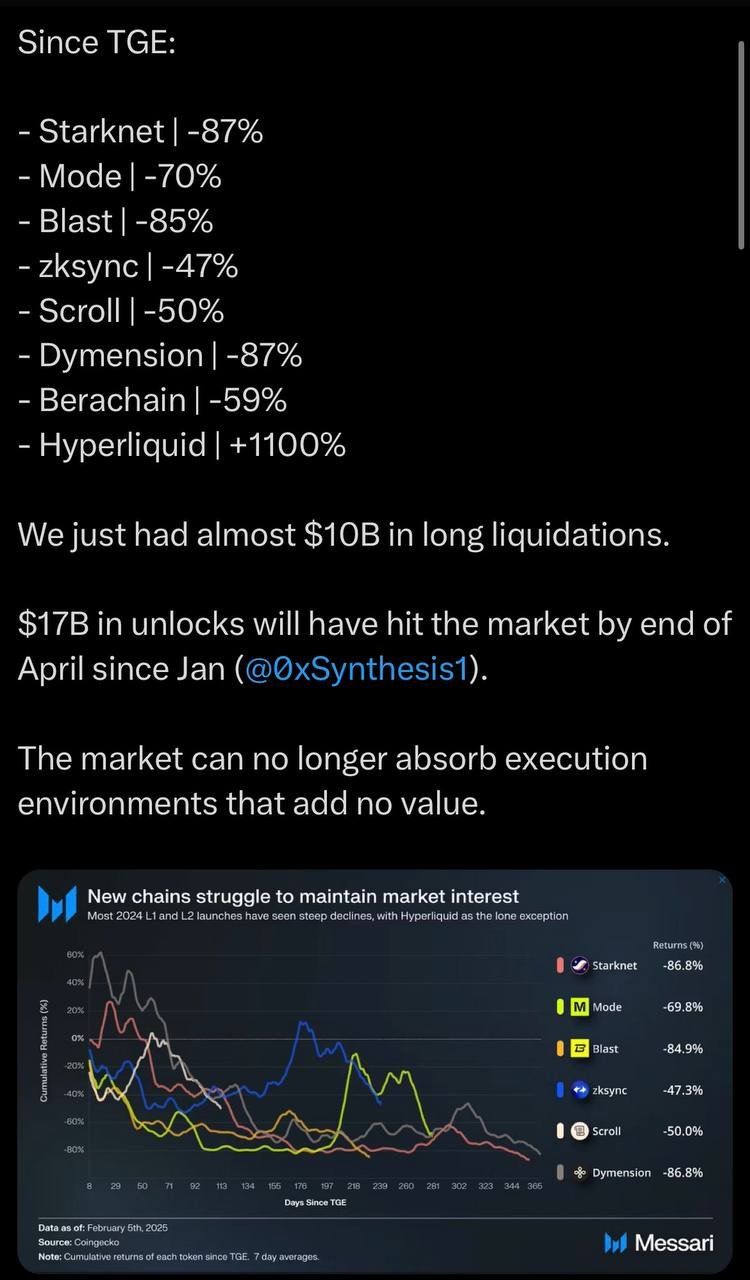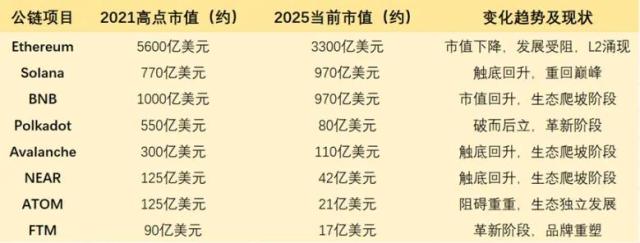Author: YettaS
The previous post received a lot of controversy because I wrote about @berachain; yesterday, @cz_binance also worked hard to revive @BNBCHAIN with memes; in the AMA with @DoveyWanCN, @forgivenever asked why we would support the Movement.
That day, when I saw @jinfizzbuzz write about @megaeth_labs, someone also said that talking about the ecology without even testing the network was very empty; these days, the TGE of @solayer_labs and @StoryProtocol is far from meeting everyone's expectations. Taking this opportunity, I would like to talk about our investment logic for public chains. Each company that does public chains has its own starting point, what I say does not represent the right answer, and I welcome discussion.
How did the public chains of the past operate?
The essence of blockchain is the "chain", and since its inception, the pre-construction of the infrastructure has become an industry convention, directly giving birth to a large number of general public chains (Generic Public Chain) with technical differentiation as the selling point. Building the infrastructure and then attracting dapp developers has become a default choice. But we all know that the infrastructure itself does not attract users, what attracts users is what? It is investment promotion, it is ICO, NFT, DeFi, Meme and other applications that can be played. However, these applications will not emerge spontaneously, how did the early public chains break through?
Relying on the charisma of the founder, relying on huge financing news, relying on massive marketing and promotion, relying on the huge wealth effect of the TGE. Nowadays, the marketing of these public chains is child's play compared to EOS, the genius-level BM, the ICO that lasted a year and raised $4 billion, and then there was nothing. Why did this seemingly empty road succeed? Because the public's attention is limited, when the Chain is in obscurity, no application or user will actively come to your ecosystem, which is why VC needs to continue investing in new public chains.
What problems have the current public chains encountered?
The current market's valuation logic for public chains is in a state of extreme distortion.
On the one hand, the market is increasingly unwilling to buy into the "infrastructure first" model, because the Generic Public Chains that have really broken out of the ecosystem can be counted on one hand, which is also one of the reasons why investors have lost trust in VC - a large amount of capital has been bet on so many public chains, but most have failed to deliver on their growth promises, the chart below from @defi_monk directly points out this problem.

But on the other hand, public chains are still the direction with the highest valuation ceiling in the entire industry. To date, no Dapp has proven it can outlive the public chain.
Ethereum has evolved over 10 years, Solana has gone through two full cycles, and the Dapps on them are still active.
In other words, although the market questions the high valuation of public chains, it is still the highest ceiling track closest to "long-termism".
So everyone loves and hates this model, hates that it has nothing to be valued so highly, loves it that if it's done well, it has such a high ceiling to benchmark against.
This is actually a legacy issue in our industry that needs to be transformed.
How to transform?
Now another path has emerged, the App Specific Chain, which started with the phenomenal @AxieInfinity, they are doing @Ronin_Network to try to bring the application layer users into the chain ecosystem, but the problem is that they haven't brought them in yet, and their own application is not on fire.
This cycle, this model has been further ignited by @HyperliquidX, and then we can see:
- @Uniswap — Unichain
- @JupiterExchange — Jupnet
- @OndoFinance — Ondo Chain
- @ethena_labs — Ethena Chain
Taking my most familiar Ethena as an example, their next application is Ethereal, a perp based on USDe, and they are starting to build an ecosystem around their core assets and applications. This may be a bit like Hangzhou? After Alibaba came out, the entire e-commerce industry rose up in Hangzhou.
This paradigm shift can be said to be because applications are the real landing point to push the industry to the masses, or it can be said to be market segmentation under commercial maturity, everyone is using different ways to attack the traditional valuation system of the industry.
What are these two models competing for?
In the public chain ecosystem, the Chain relies on large-scale infrastructure publicity and financing narratives to attract Dapp developers to settle in, and ultimately achieve user retention through the application ecosystem. While Dapps directly acquire users through real application scenarios, and gradually build their own ecosystem under the user migration and synergistic effects, eventually evolving into a chain.
From "virtual" to "real", from "real" to "virtual", the same destination. What is the essence behind this? The essence is the dispute over Distribution, who can more efficiently acquire users and achieve retention.

In Web2, the barriers to Distribution are much higher than the product, because the marginal cost of most products tends to zero, while the competitive barriers of distribution channels are extremely high.
Distribution means monopolizing traffic entry + platform network effects + data monopoly, and they together shape the core competitiveness of Web2 companies.
Take TikTok as an example:
- Monopoly of traffic entry: TikTok seized the short video opportunity and became the new generation of traffic entry
- Platform network effects: Established a two-sided market of creators-audience-advertisers, and user stickiness continues to increase as content supply increases
- Data monopoly: Massive user data trains the recommendation algorithm, continuously improving distribution accuracy and forming a powerful data barrier
Why did we invest in Hooked? We've always said this is a web2.5 product, because Tap to earn is actually a long-proven effective user acquisition model that can obtain huge external traffic, but what it was eventually falsified is that: the user traffic quality brought by the airdrop is low, the conversion rate is not enough, even if the traffic is efficiently acquired, but the retention cannot be achieved. This is also the reason why we subsequently chose to pass all Telegram tap-to-earn projects - change the channel, the model remains unchanged, and the user quality is still not high.
Returning to this business essence, the Distribution logic exists in web3 as well, only the way of user acquisition is different.
In the past, Generic Public Chain did not have mature product support, could not rely on products to acquire traffic, let alone talk about monopoly effects. Therefore, its main way of occupying Awareness is:
- Technological pioneer feeling: Attracting early developers and geeks
- Founder's charisma and cultural uniqueness: Shaping a sense of identity and forming a community
- Financing and Token incentives: Driving user growth in the short term
However, the success or failure of this model completely depends on the "strength of consensus" - when it is strongly shaped, it can build an ecosystem moat; when it is weakly shaped, the market direction changes, the traffic will be scattered.
Nowadays, more and more App Specific Chains are emerging, indicating that Web3 is gradually returning to the business model of Web2 - driven by real applications, through market segmentation and private domain traffic refined operations, to complete efficient conversion and long-term retention.
I tend to believe that the growth logic of this model is healthier and more in line with the evolutionary direction of the real business world.
What will the future be like?
The coexistence of these two paths to some extent reflects that the industry is still in the early stage - no single model has formed an absolute monopoly, and the paradigmatic shift has not yet occurred.
All investments are essentially judgments of the "trend". Where are we at this point in time? Generic Public Chain has not yet been falsified, but as the demand for breaking the circle has risen sharply, relying solely on technology narratives or financing narratives is difficult to gather enough consensus; at the same time, the paradigm shift from "build super dapp" to "build chain" has not yet been proven. This is not just a switch between products and infrastructure, but an ability to leap from a product mindset driven by PMF to the ability to shape culture and build ecosystems, and the founders with this transformative evolutionary capability are few and far between.
Both have opportunities and challenges, the real divide is - they require completely different abilities from the founders. The core of venture capital is to bet on the market pricing based on these judgments of "trend", "matter", and "people" in the face of extreme uncertainty, taking the risk of failure in exchange for the ultimate risk return.







